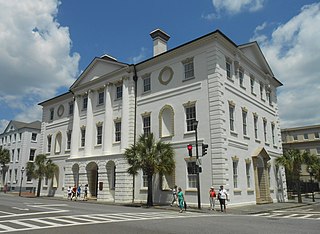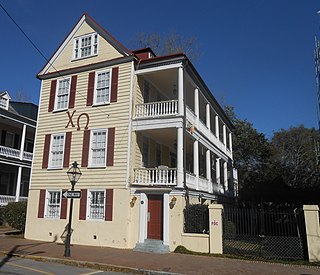
Walterboro is a city in Colleton County, South Carolina, United States. The city's population was 5,398 at the 2010 census. It is the county seat of Colleton County. Walterboro is located 48 miles (77 km) west of Charleston and is located near the ACE Basin region in the South Carolina Lowcountry. It is known as "The Front Porch of the Lowcountry".

Court House Square is the location of Charleston County Courthouse in downtown Charleston, South Carolina, at the intersection of Meeting and Broad Streets. It is historically known as "the Four Corners of Law" because the intersection hosted buildings from each level of government: the Courthouse, City Hall, the Federal Building and U.S. Post Office, and Saint Michael's Episcopal Church.
St. Michael's Churchyard, adjacent to historic St. Michael's Episcopal Church on the corner of Meeting and Broad Streets, in Charleston, South Carolina is the final resting place of some famous historical figures, including two signers of the Constitution of the United States. The church was established in 1751 as the second Anglican parish in Charleston, South Carolina.

The Anglican Diocese of South Carolina (ADOSC) is a diocese of the Anglican Church in North America (ACNA). The diocese covers an area of 24 counties in the eastern part of the state of South Carolina. In 2019, it had 18,195 baptized members and 47 parishes. The see city is Charleston, home to the Cathedral of St. Luke and St. Paul.
Rainbow Row is the name for a series of thirteen colorful historic houses in Charleston, South Carolina. The houses are located north of Tradd St. and south of Elliott St. on East Bay Street, that is, 79 to 107 East Bay Street. The name Rainbow Row was coined after the pastel colors they were painted as they were restored in the 1930s and 1940s. It is a popular tourist attraction and is one of the most photographed parts of Charleston.

St. Mary of the Annunciation Catholic Church is a Catholic church in Charleston, South Carolina, and was the first Catholic parish established in the Carolinas and Georgia. The current building at 93 Hasell Street and is the third structure to house the congregation on this site.

Charleston Library Society, founded in 1748, is a subscription library in Charleston, South Carolina.

The Huguenot Church, also called the French Huguenot Church or the French Protestant Church, is a Gothic Revival church located at 136 Church Street in Charleston, South Carolina. Built in 1844 and designed by architect Edward Brickell White, it is the oldest Gothic Revival church in South Carolina, and has been designated a National Historic Landmark and listed on the National Register of Historic Places. The congregation it serves traces its origins to the 1680s, and is the only independent Huguenot church in the United States.

Strawberry Chapel is a parochial chapel of ease in the lower part of St. John's, Berkeley Parish in Berkeley County, South Carolina that was built in 1725. It is on Strawberry Chapel Road between South Carolina State Highway 8-44 and the West Branch of the Cooper River. Bordering Strawberry's property is the South Carolina State owned historic site of the “Town of Childsbury.” It was a planned community that was settled in 1707. The town no longer exists. They were named to the National Register of Historic Places on April 26, 1972.

The Biggin Church Ruins are the ruins of a church in Berkeley County, South Carolina. Biggin Church is its name in the USGS Geographic Names Information System. The ruins are about 2 mi (3 km) from Moncks Corner, South Carolina, near the intersection of South Carolina Highway 402 and State Highway 8-376. The church has been burned three times since it was first constructed in about 1711. It was the church of the parish of St. John's, Berkeley The ruins are from the church built in 1761 and its reconstruction in 1781. It was included in the National Register of Historic Places on December 13, 1977. UPDATE 11/2019: Biggin Church Ruins remain part of Strawberry Chapel’s land.

John W. Priest (1825-1859) was a noted American architect from New York and founding member of the American Institute of Architects.
The following is a timeline of the history of Charleston, South Carolina, USA.

The Episcopal Diocese of South Carolina (EDOSC), known as The Episcopal Church in South Carolina from January 2013 until September 2019, is a diocese of the Episcopal Church. The diocese covers an area of 24 counties in the eastern part of the U.S. state of South Carolina. The see city is Charleston, home to Grace Church Cathedral and the diocesan headquarters. The western portion of the state forms the Episcopal Diocese of Upper South Carolina. As a diocese of the Episcopal Church, the Diocese of South Carolina is part of the worldwide Anglican Communion and traces its heritage to the beginnings of Christianity.

The John McKee House is a c. 1796 house at 44 King St., Charleston, South Carolina. The house follows a traditional Charleston single house layout with a small stair hall separating two main rooms per floor, one toward the street and one toward the rear of the property. The brickwork suggests that a door originally entered the house from King St., but it was replaced with a window at some point. Its first known owner was John McKee who died without heirs, leaving the house to the Methodist Episcopal Church. When the church divided in 1845, the house became the joint property of three black churches: Centenary, Wesley, and Old Bethel. The Methodist Episcopal Church rented the property out until 1915. In 1929, Mrs. Victor Morawetz of Fenwick Hall, Johns Island, bought the house.

The John Scott House at 38 Coming Street is one of the two oldest buildings on the Charleston, South Carolina campus of the College of Charleston.
The Episcopal Diocese of South Carolina was established in 1785 as one of the nine original dioceses of the Episcopal Church in the United States. The diocese originally covered the entire state of South Carolina, but the western part of the state became the Episcopal Diocese of Upper South Carolina in 1922. In 2012, a controversy led to the existence of two rival dioceses, the Anglican Diocese of South Carolina and the Episcopal Diocese of South Carolina, each claiming to be the legitimate successor of the original diocese.

St. Stephen's Episcopal Church is an Episcopal parish in Charleston, South Carolina, founded in 1822. It was the first Episcopal church in the United States at which pews were offered to attendants at no cost; other Episcopal churches either sold or leased pews to members to fund the churches. The church was named as a contributing property to the Charleston Historic District when it was expanded in 1970.

St. John's Reformed Episcopal Church is a historic African-American Anglican church in Charleston, South Carolina. Founded in 1906 and occupying a building built in 1850, the church is a member of the Reformed Episcopal Church's Diocese of the Southeast.

St. Andrew's Church is a multisite Anglican congregation in Mount Pleasant and Charleston, South Carolina. First established in 1835, its 1857 building is a contributing property to the Mount Pleasant Historic District. The church holds services at two other locations: downtown Charleston and North Charleston.
















